Working with chemical structures in computational chemistry often requires converting between different molecular representations. One of the most common tasks is transforming SMILES (Simplified Molecular Input Line Entry System) strings into visual 2D molecular structures.
Today, I’ll walk you through building a Python tool that converts SMILES notation into molecular images, complete with molecular formulas and proper formatting.
What Are SMILES Strings?
SMILES is a compact way to represent molecular structures as text strings. For example:
CCOrepresents ethanol (H₃C-CH₂-OH)C1=CC=CC=C1represents benzeneCC(=O)Orepresents acetic acid
The notation uses simple rules: C for carbon, O for oxygen, = for double bonds, parentheses for branches, and numbers for ring closures. It’s widely used in cheminformatics because it’s both human-readable and machine-parseable.
The Challenge
While SMILES strings are great for data storage and computation, they’re not ideal for human interpretation or publication. I need a way to:
- Parse SMILES strings reliably
- Generate clean 2D molecular coordinates
- Render good-quality images
- Add informative legends with molecular formulas
- Handle edge cases and provide good error messages
Building the Solution
Let me build a tool using RDKit for chemical processing and PIL for image manipulation.
Core Dependencies
from rdkit import Chem
from rdkit.Chem import Draw, rdDepictor, rdMolDescriptors
from PIL import Image, ImageDraw, ImageFont
RDKit handles the chemical logic, while PIL gives us fine control over the final image appearance.
The Main Conversion Function
Here’s the core of the converter:
def create_molecule_image(
mol: Chem.Mol, smiles_string: str, size: int = 500
) -> Image.Image:
"""
Creates a molecule image with a legend showing molecular formula and SMILES string.
"""
# Calculate dynamic sizes based on image size
sizes = _calculate_dynamic_sizes(size)
# Generate 2D coordinates and molecular formula
rdDepictor.Compute2DCoords(mol)
molecular_formula = rdMolDescriptors.CalcMolFormula(mol)
# Create the base molecular structure image
mol_img = Draw.MolToImage(mol, size=(size, size))
if mol_img.mode != "RGBA":
mol_img = mol_img.convert("RGBA")
# Extend image to include legend space
total_height = size + sizes['legend_height']
final_img = Image.new("RGBA", (size, total_height), "white")
final_img.paste(mol_img, (0, 0))
# Add formatted legend
draw = ImageDraw.Draw(final_img)
font_regular, font_small = _load_fonts(sizes['regular_font_size'], sizes['subscript_font_size'])
_draw_molecular_formula(draw, molecular_formula, font_regular, font_small, sizes, size)
_draw_smiles_legend(draw, smiles_string, font_regular, sizes, molecular_formula, size)
return final_img
Dynamic Sizing for Scalability
One useful approach is making everything scale with image size:
def _calculate_dynamic_sizes(image_size: int):
"""Calculate dynamic sizing values based on image size."""
return {
'legend_height': int(image_size * 0.08),
'legend_y_offset': int(image_size * 0.02),
'legend_x_offset': int(image_size * 0.02),
'subscript_y_offset': int(image_size * 0.006),
'regular_font_size': int(image_size * 0.028),
'subscript_font_size': int(image_size * 0.02),
}
This ensures the legends and text remain proportional whether generating 300px thumbnails or 1200px poster images.
Proper Chemical Formula Formatting
Chemical formulas need subscripts, which requires custom text rendering:
def _draw_molecular_formula(
draw: ImageDraw.Draw, formula: str, font_regular, font_small, sizes: dict, image_size: int
) -> int:
"""Draw molecular formula with proper subscript formatting."""
y_pos = image_size + sizes['legend_y_offset']
x_pos = sizes['legend_x_offset']
draw.text((x_pos, y_pos), "Formula: ", fill="black", font=font_regular)
x_pos += draw.textlength("Formula: ", font=font_regular)
# Render each character with proper sizing
for char in formula:
if char.isdigit():
# Numbers become subscripts
draw.text(
(x_pos, y_pos + sizes['subscript_y_offset']),
char, fill="black", font=font_small
)
x_pos += draw.textlength(char, font=font_small)
else:
# Letters stay regular size
draw.text((x_pos, y_pos), char, fill="black", font=font_regular)
x_pos += draw.textlength(char, font=font_regular)
return x_pos
Examples in Action
Let me show the tool in action with some common molecules:
Simple Molecules
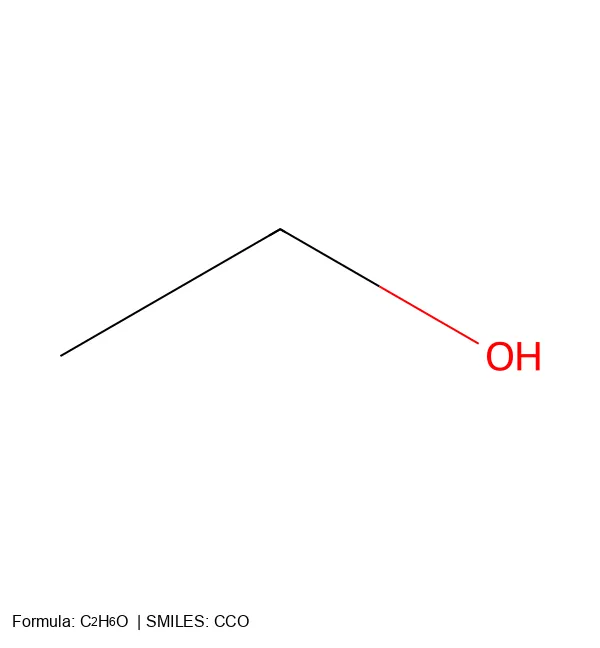
The ethanol example shows how even simple molecules benefit from clear visualization. The SMILES string CCO becomes an immediately recognizable structure.
Aromatic Compounds
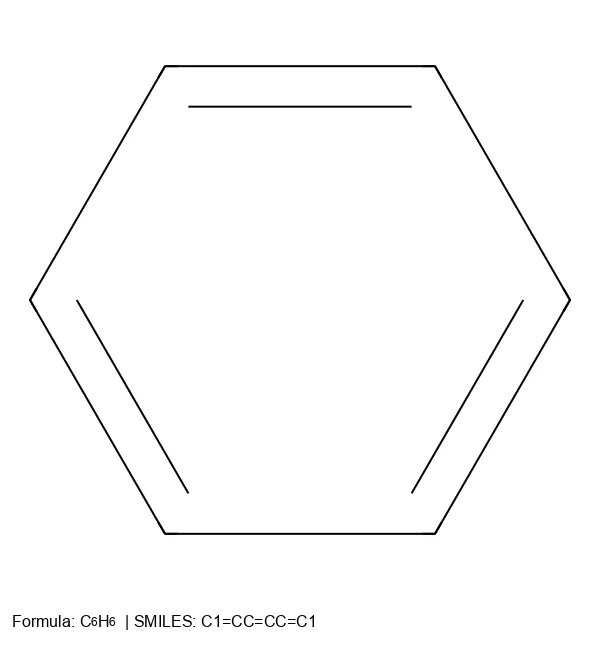
Benzene demonstrates how the tool handles ring structures. The SMILES notation C1=CC=CC=C1 uses numbers to indicate ring closure points.
Complex Pharmaceuticals
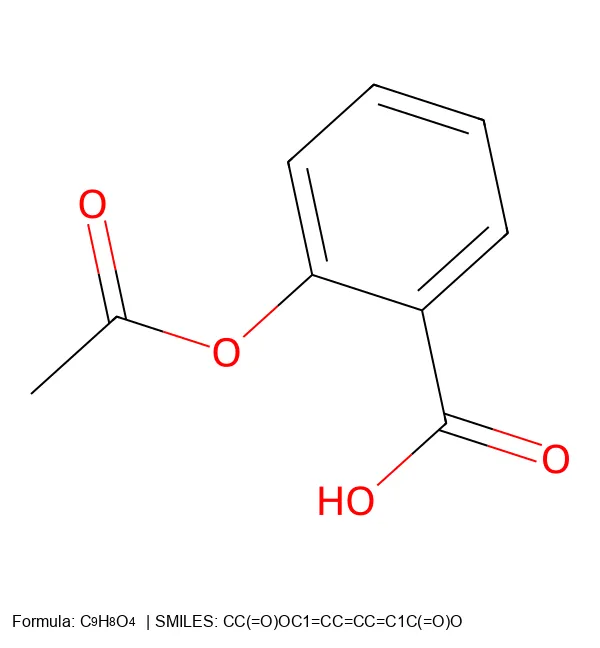
Aspirin shows the tool’s ability to handle complex molecules with multiple functional groups. The resulting image clearly shows the benzene ring, carboxyl group, and acetyl ester.
Substituted Aromatics
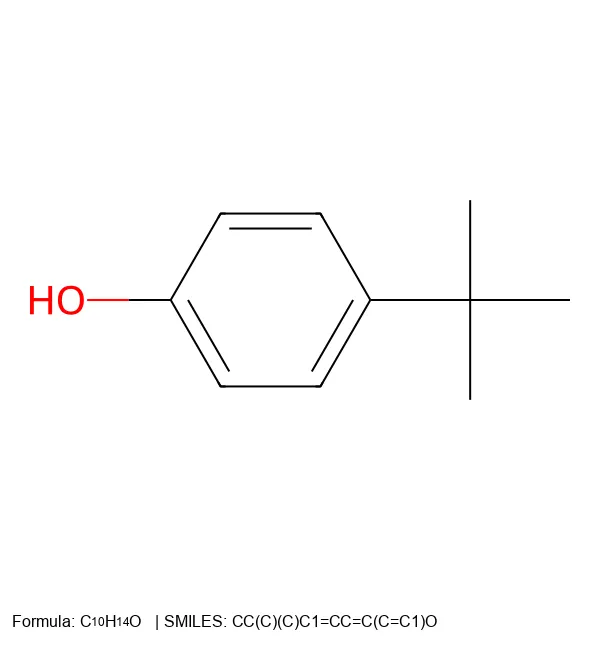
This example shows how the tool handles substituted aromatic compounds with bulky groups like tert-butyl.
Command-Line Interface
The tool includes a comprehensive CLI for easy use:
# Basic usage with auto-generated filename
python smiles2png.py "CCO"
# Custom output filename
python smiles2png.py "CC(=O)OC1=CC=CC=C1C(=O)O" -o aspirin.png
# Large image for presentations
python smiles2png.py "C1=CC=CC=C1" --size 800
# Verbose output for debugging
python smiles2png.py "CCO" --verbose
The CLI automatically handles:
- Safe filename generation from SMILES hashes
- Input validation and error reporting
- Automatic PNG extension addition
- Comprehensive help and examples
Error Handling and Validation
Good error handling is important for a reliable tool:
def smiles_to_png(
smiles_string: str, output_file: str, size: int = 500
) -> None:
"""Convert a SMILES string to a PNG image with comprehensive error handling."""
# Input validation
if not smiles_string or not smiles_string.strip():
raise ValueError("SMILES string cannot be empty")
if size <= 0:
raise ValueError(f"Image size must be positive, got: {size}")
# Ensure output directory exists
output_path = Path(output_file)
output_path.parent.mkdir(parents=True, exist_ok=True)
# Parse and validate SMILES
mol = Chem.MolFromSmiles(smiles_string.strip())
if mol is None:
raise ValueError(
f"Invalid SMILES string: '{smiles_string}'. "
f"Please check the syntax and try again."
)
# Generate and save image
img = create_molecule_image(mol, smiles_string.strip(), size)
try:
img.save(output_file, "PNG", optimize=True)
print(f"Image successfully saved to: {output_file}")
except Exception as e:
raise IOError(f"Failed to save image to '{output_file}': {e}")
The function provides clear, actionable error messages for common problems like invalid SMILES syntax or file permission issues.
Handling Complex Molecules and Long SMILES Strings
One challenge that came up during development was handling very long SMILES strings for complex molecules. Large pharmaceutical compounds or steroids can have SMILES strings that exceed the image width, causing text truncation in the legend.
The Text Overflow Problem
Initially, the legend rendering was simple - it placed everything on a single line:
# Old approach - prone to overflow
draw.text((x_pos, y_pos), f" | SMILES: {smiles}", fill="black", font=font)
This worked fine for simple molecules like ethanol (CCO) or benzene (C1=CC=CC=C1), but failed for complex structures.
Intelligent Text Wrapping Solution
I implemented a dynamic layout system that:
- Measures available space based on formula length
- Wraps to new lines when SMILES strings are too long
- Breaks at logical boundaries in SMILES notation
- Adjusts image height dynamically to accommodate wrapped text
def _draw_smiles_legend(
draw: ImageDraw.Draw, smiles: str, font_regular, sizes: dict, formula: str, image_size: int
) -> None:
"""Add SMILES string to the image legend with proper text wrapping."""
# Calculate if SMILES fits on same line as formula
available_width = image_size - prefix_width - margins
smiles_width = draw.textlength(smiles, font=font_regular)
if smiles_width <= available_width:
# Single line layout
draw.text((x_pos, y_pos), f" | SMILES: {smiles}", fill="black", font=font_regular)
else:
# Multi-line layout with intelligent wrapping
_draw_wrapped_text(draw, smiles, x_pos, y_pos, remaining_width, font_regular, sizes)
Complex Molecule Examples
Here are examples showing the improved text handling:
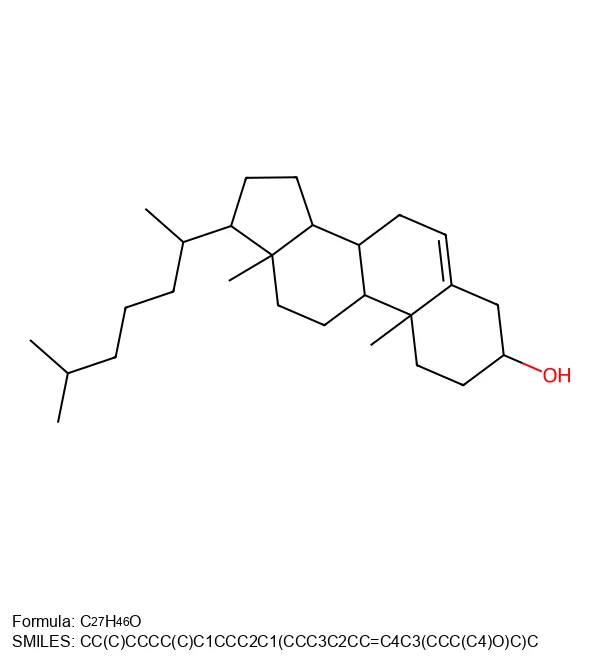
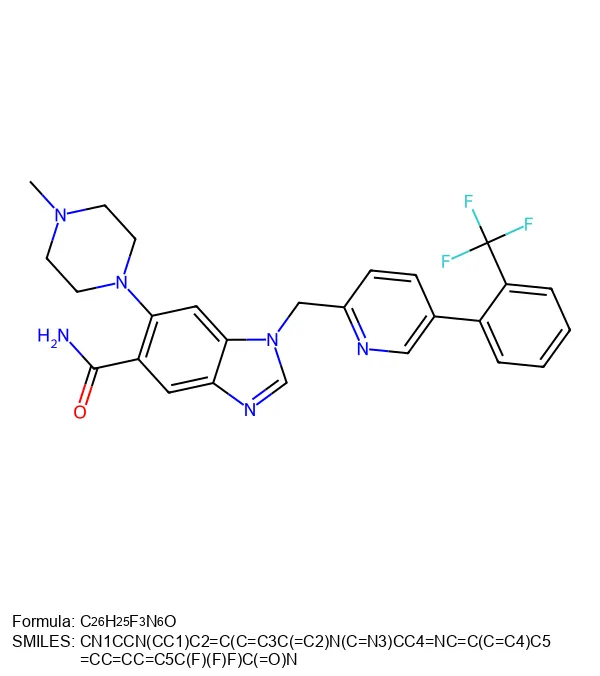
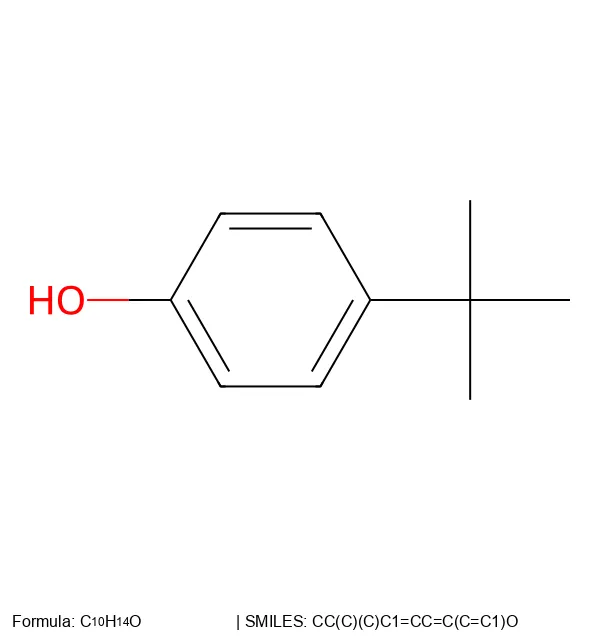
The text wrapping system breaks SMILES strings at logical boundaries like parentheses and brackets, preserving readability while ensuring no information is lost to truncation.
Cross-Platform Font Handling
One challenge is ensuring consistent text rendering across different operating systems:
FONT_PATHS = [
"/System/Library/Fonts/Arial.ttf", # macOS
"/usr/share/fonts/truetype/arial.ttf", # Linux
"C:/Windows/Fonts/arial.ttf", # Windows
]
def _load_fonts(regular_size: int, subscript_size: int):
"""Load system fonts with fallback to default font."""
font_regular = None
font_small = None
for font_path in FONT_PATHS:
try:
font_regular = ImageFont.truetype(font_path, regular_size)
font_small = ImageFont.truetype(font_path, subscript_size)
break
except (OSError, IOError):
continue
# Fallback to default font if system fonts unavailable
if font_regular is None:
font_regular = ImageFont.load_default()
font_small = ImageFont.load_default()
return font_regular, font_small
This approach handles different operating systems while providing a consistent experience.
Use Cases and Applications
This tool is useful for:
Research Publications: Generate consistent, high-quality molecular figures for papers and presentations, including complex pharmaceutical compounds and natural products.
Educational Materials: Create clear molecular structures for teaching chemistry concepts, from simple molecules to complex steroids and drug molecules.
Chemical Databases: Automatically generate visual representations for large compound databases, with reliable text handling for molecules of any complexity.
Pharmaceutical Research: Visualize drug candidates and complex synthetic intermediates with full structural detail preserved in the legends.
Web Applications: Provide real-time molecular visualization in cheminformatics web tools, with confidence that even the most complex structures will render properly.
Documentation: Include molecular structures in technical documentation and reports, with professional formatting suitable for publication.
Performance Considerations
For batch processing large numbers of molecules:
- Reuse RDKit objects: Don’t recreate molecular objects unnecessarily
- Cache font objects: Load fonts once and reuse across multiple images
- Optimize image sizes: Use appropriate resolutions for your use case
- Parallel processing: The tool is thread-safe for concurrent image generation
Extending the Tool
The modular design makes extensions straightforward:
- 3D coordinates: Modify to use 3D conformers with RDKit’s 3D embedding
- Custom highlighting: Add atom or bond highlighting for specific substructures
- Different output formats: Support SVG, PDF, or other vector formats
- Style customization: Add themes for different publication styles
- Batch processing: Create wrapper functions for processing SMILES lists
Conclusion
Converting SMILES strings to visual molecular structures is a common need in computational chemistry. By combining RDKit’s chemical intelligence with PIL’s image processing capabilities, I can create a tool that generates molecular images for molecules of any complexity.
The key principles for building useful scientific tools are:
- Good error handling with clear, actionable messages
- Scalable design that works across different use cases, from simple molecules to complex pharmaceuticals
- Intelligent text handling that prevents information loss through truncation
- Cross-platform compatibility for broad adoption
- Clear documentation with practical examples
- Modular architecture for easy extension and maintenance
This tool demonstrates how Python’s scientific ecosystem enables building useful solutions for scientific problems. The text wrapping improvements ensure that even complex molecular structures - from steroids to multi-ring pharmaceutical compounds - can be visualized with complete structural information preserved.
Whether you’re generating figures for a paper, building a chemical database, or creating educational materials, having reliable tools for molecular visualization that handle complexity well is helpful.
The implementation provides a foundation that you can adapt for your specific needs, whether that’s batch processing thousands of compounds, creating custom styling for particular applications, or integrating into larger cheminformatics workflows.
Download the Complete Script
You can copy the complete smiles2png.py script directly from the code block below.
Installation and Setup
Before using the script, install the required dependencies:
pip install rdkit pillow
Complete Script
Click to expand the complete smiles2png.py script
#!/usr/bin/env python
# -*- coding: utf-8 -*-
"""
SMILES to PNG Converter
======================
A command-line utility to render SMILES strings as 2D molecular images with
molecular formulas and proper subscript formatting.
This script demonstrates how to:
- Parse SMILES strings using RDKit
- Generate 2D molecular coordinates
- Create publication-quality molecular images
- Add custom legends with molecular formulas
- Handle font rendering and subscripts
Example Usage:
python smiles2png.py "CCO" # Ethanol
python smiles2png.py "CC(=O)OC1=CC=CC=C1C(=O)O" -o aspirin.png # Aspirin
python smiles2png.py "C1=CC=CC=C1" --size 800 # Benzene, larger image
Author: Hunter Heidenreich
Website: https://hunterheidenreich.com
"""
import argparse
import hashlib
import sys
from pathlib import Path
# RDKit imports
from rdkit import Chem
from rdkit.Chem import Draw, rdDepictor, rdMolDescriptors
# PIL imports for image manipulation
from PIL import Image, ImageDraw, ImageFont
# Constants for image configuration
DEFAULT_IMAGE_SIZE = 500
LEGEND_HEIGHT_RATIO = 0.08 # Legend height as ratio of image size
LEGEND_Y_OFFSET_RATIO = 0.02 # Y offset as ratio of image size
LEGEND_X_OFFSET_RATIO = 0.02 # X offset as ratio of image size
SUBSCRIPT_Y_OFFSET_RATIO = 0.006 # Subscript offset as ratio of image size
# Font size ratios based on image size
REGULAR_FONT_RATIO = 0.028 # Regular font size as ratio of image size
SUBSCRIPT_FONT_RATIO = 0.02 # Subscript font size as ratio of image size
# Font paths for different operating systems
FONT_PATHS = [
"/System/Library/Fonts/Arial.ttf", # macOS
"/usr/share/fonts/truetype/arial.ttf", # Linux
"C:/Windows/Fonts/arial.ttf", # Windows
]
def _calculate_dynamic_sizes(image_size: int):
"""Calculate dynamic sizing values based on image size."""
return {
'legend_height': int(image_size * LEGEND_HEIGHT_RATIO),
'legend_y_offset': int(image_size * LEGEND_Y_OFFSET_RATIO),
'legend_x_offset': int(image_size * LEGEND_X_OFFSET_RATIO),
'subscript_y_offset': int(image_size * SUBSCRIPT_Y_OFFSET_RATIO),
'regular_font_size': int(image_size * REGULAR_FONT_RATIO),
'subscript_font_size': int(image_size * SUBSCRIPT_FONT_RATIO),
}
def _load_fonts(regular_size: int, subscript_size: int):
"""Load system fonts for text rendering, with fallback to default font."""
font_regular = None
font_small = None
for font_path in FONT_PATHS:
try:
font_regular = ImageFont.truetype(font_path, regular_size)
font_small = ImageFont.truetype(font_path, subscript_size)
break
except (OSError, IOError):
continue
if font_regular is None:
font_regular = ImageFont.load_default()
font_small = ImageFont.load_default()
return font_regular, font_small
def create_molecule_image(
mol: Chem.Mol, smiles_string: str, size: int = DEFAULT_IMAGE_SIZE
) -> Image.Image:
"""
Creates a molecule image with a legend showing molecular formula and SMILES string.
Args:
mol: RDKit molecule object (already validated)
smiles_string: Original SMILES string for legend display
size: Image size in pixels (square image)
Returns:
PIL Image object with molecule structure and formatted legend
"""
# Calculate dynamic sizes based on image size
sizes = _calculate_dynamic_sizes(size)
rdDepictor.Compute2DCoords(mol)
molecular_formula = rdMolDescriptors.CalcMolFormula(mol)
mol_img = Draw.MolToImage(mol, size=(size, size))
if mol_img.mode != "RGBA":
mol_img = mol_img.convert("RGBA")
total_height = size + sizes['legend_height']
final_img = Image.new("RGBA", (size, total_height), "white")
final_img.paste(mol_img, (0, 0))
draw = ImageDraw.Draw(final_img)
font_regular, font_small = _load_fonts(sizes['regular_font_size'], sizes['subscript_font_size'])
_draw_molecular_formula(draw, molecular_formula, font_regular, font_small, sizes, size)
_draw_smiles_legend(draw, smiles_string, font_regular, sizes, molecular_formula, size)
return final_img
def _draw_molecular_formula(
draw: ImageDraw.Draw, formula: str, font_regular, font_small, sizes: dict, image_size: int
) -> int:
"""Draw molecular formula with proper subscript formatting."""
y_pos = image_size + sizes['legend_y_offset']
x_pos = sizes['legend_x_offset']
draw.text((x_pos, y_pos), "Formula: ", fill="black", font=font_regular)
x_pos += draw.textlength("Formula: ", font=font_regular)
for char in formula:
if char.isdigit():
draw.text(
(x_pos, y_pos + sizes['subscript_y_offset']), char, fill="black", font=font_small
)
x_pos += draw.textlength(char, font=font_small)
else:
draw.text((x_pos, y_pos), char, fill="black", font=font_regular)
x_pos += draw.textlength(char, font=font_regular)
return x_pos
def _draw_smiles_legend(
draw: ImageDraw.Draw, smiles: str, font_regular, sizes: dict, formula: str, image_size: int
) -> None:
"""Add SMILES string to the image legend."""
y_pos = image_size + sizes['legend_y_offset']
formula_width = sum(
draw.textlength(char, font_regular) for char in f"Formula: {formula}"
)
x_pos = sizes['legend_x_offset'] + formula_width
separator = " | SMILES: "
draw.text((x_pos, y_pos), separator, fill="black", font=font_regular)
x_pos += draw.textlength(separator, font=font_regular)
draw.text((x_pos, y_pos), smiles, fill="black", font=font_regular)
def smiles_to_png(
smiles_string: str, output_file: str, size: int = DEFAULT_IMAGE_SIZE
) -> None:
"""
Convert a SMILES string to a PNG image with molecular formula legend.
Args:
smiles_string: Valid SMILES string representing a molecule
output_file: Path where the PNG image will be saved
size: Square image dimensions in pixels
Raises:
ValueError: If SMILES string is invalid or size is non-positive
IOError: If file cannot be saved to the specified location
"""
if not smiles_string or not smiles_string.strip():
raise ValueError("SMILES string cannot be empty")
if size <= 0:
raise ValueError(f"Image size must be positive, got: {size}")
output_path = Path(output_file)
output_path.parent.mkdir(parents=True, exist_ok=True)
mol = Chem.MolFromSmiles(smiles_string.strip())
if mol is None:
raise ValueError(
f"Invalid SMILES string: '{smiles_string}'. "
f"Please check the syntax and try again."
)
img = create_molecule_image(mol, smiles_string.strip(), size)
try:
img.save(output_file, "PNG", optimize=True)
print(f"Image successfully saved to: {output_file}")
except Exception as e:
raise IOError(f"Failed to save image to '{output_file}': {e}")
def create_safe_filename(smiles_string: str) -> str:
"""
Generate a filesystem-safe filename from a SMILES string using MD5 hash.
Args:
smiles_string: The input SMILES string
Returns:
A safe filename ending with .png
"""
clean_smiles = smiles_string.strip()
hasher = hashlib.md5(clean_smiles.encode("utf-8"))
return f"{hasher.hexdigest()}.png"
def main() -> None:
"""Command-line interface for the SMILES to PNG converter."""
parser = argparse.ArgumentParser(
description="Convert SMILES strings to publication-quality PNG images with molecular formulas.",
epilog="""
Examples:
%(prog)s "CCO" # Ethanol with auto-generated filename
%(prog)s "CC(=O)OC1=CC=CC=C1C(=O)O" # Aspirin with auto-generated filename
%(prog)s "C1=CC=CC=C1" -o benzene.png # Benzene with custom filename
%(prog)s "CCO" --size 800 # Ethanol with larger image size
Common SMILES patterns:
CCO - Ethanol
CC(=O)O - Acetic acid
C1=CC=CC=C1 - Benzene
CC(C)C - Isobutane
NC(=O)C1=CC=CC=C1 - Benzamide
""",
formatter_class=argparse.RawDescriptionHelpFormatter,
)
parser.add_argument(
"smiles",
type=str,
help="SMILES string of the molecule to visualize (e.g., 'CCO' for ethanol)",
)
parser.add_argument(
"-o",
"--output",
type=str,
metavar="FILE",
help="Output PNG filename. If not provided, generates a unique filename "
"based on the SMILES string hash. Extension .png will be added if missing.",
)
parser.add_argument(
"-s",
"--size",
type=int,
default=DEFAULT_IMAGE_SIZE,
metavar="PIXELS",
help=f"Square image size in pixels (default: {DEFAULT_IMAGE_SIZE}). "
f"Typical values: 300 (small), 500 (medium), 800 (large).",
)
parser.add_argument(
"-v",
"--verbose",
action="store_true",
help="Enable verbose output for debugging",
)
args = parser.parse_args()
if args.verbose:
print(f"Input SMILES: {args.smiles}")
print(f"Image size: {args.size}x{args.size} pixels")
if args.output:
output_filename = (
args.output
if args.output.lower().endswith(".png")
else f"{args.output}.png"
)
if args.verbose:
print(f"Using custom filename: {output_filename}")
else:
output_filename = create_safe_filename(args.smiles)
if args.verbose:
print(f"Generated filename: {output_filename}")
try:
smiles_to_png(args.smiles, output_filename, args.size)
if args.verbose:
print("Conversion completed successfully!")
except ValueError as e:
print(f"Input Error: {e}", file=sys.stderr)
print("Tip: Check your SMILES string syntax", file=sys.stderr)
sys.exit(1)
except IOError as e:
print(f"File Error: {e}", file=sys.stderr)
print("Tip: Check file permissions and disk space", file=sys.stderr)
sys.exit(2)
except ImportError as e:
print(f"Dependencies Error: {e}", file=sys.stderr)
print(
"Tip: Install required packages with 'pip install rdkit pillow'",
file=sys.stderr,
)
sys.exit(3)
except Exception as e:
print(f"Unexpected Error: {e}", file=sys.stderr)
print("Tip: Please report this issue if it persists", file=sys.stderr)
sys.exit(4)
if __name__ == "__main__":
main()
Quick Start
- Save the script as
smiles2png.py - Install dependencies:
pip install rdkit pillow - Run:
python smiles2png.py "CCO" -o ethanol.png
The script is ready to use and includes error handling, cross-platform font support, and help documentation. Feel free to modify it for your specific needs or integrate it into larger cheminformatics workflows.
